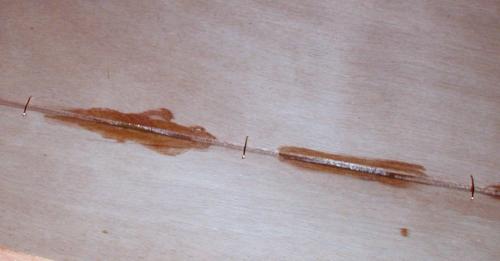Builders' Forum |
|
| ↓ Scroll to Last Comment ↓ | Forum Guidelines | Builders' Forum | |
Any recommendations for glueing/fileting process for a wire tie stitched boat? ... looks like the wire ties will be difficult to hide, or press down into the corners (unlike malleable copper wire) when boat is ready for glue and filets. ... Should i go to the tabbing approach instead (i.e. glue tabs in between ties, then remove ties when glue is cured , then apply filet ?
(by the way, building a CH 17LT)
8 replies:
RE: Stitching w/Wire Ties
Laszlo - thanks - great answer ... any advice on tabbing process (i.e. do i use a regular filet between ties, regular epoxy/woodflour mix, etc.) ...or is there an easier trick that will prevent sanding? ... any pictures on your tabs, that would make following filet easier ?
RE: Stitching w/Wire Ties
As Laszlo says, tabbing is the way to go. I did not do it on my first two kayaks (CH16) but on my third, a Mill Creek 16.5 I tabbed on the outside seams (which have to be filled anyway) then removed the stitches. The tabs were plenty strong enough to hold everything together while I filleted the inside seams with nice small fillets. I think tabbing and stitch removal should be the standard for all builds. It's an extra step but it saves lots of epoxy/filler as well as the frustration of trying to fillet around wires every 4 inches.
Chris
RE: Stitching w/Wire Ties
Here's a shot of how I did the tacks. It's basically just smearing some epoxy/woodflour putty into the cracks between the edges on the inside (there's plastic packing tape on the outside to catch drips). For nice smooth, small fillets, it's important that the tacks be as low profile as possible. A good flat smear a couple of inches long has enough surface area to give a strong bond. Be sure to let the tacks cure at least 24 hours, longer in cold weather, before taking out the wires. Once the wires are out, it's just a normal filleting job.
Laszlo

RE: Stitching w/Wire Ties
Laszlo, what is the difference between wood flour and cell-o-fill in terms of glueing strength?
Scott
RE: Stitching w/Wire Ties
Scott,
Don't know, I've never used the stuff. But letting my deducer run wild, I'd say none for the purposes of building a 17LT. Both are there just to keep the epoxy from flowing out of the joint. In each case, it's the epoxy which does the actual bonding. The wood flour is mostly chopped lignin fibers and the cell-o-fill is derived from alpha cellulose (basically chopped paper fibers).
From my point of view, the biggest difference is that in the photos on the MAS website, cell-o-fill is light blue when mixed with epoxy. That's not something I'd use on a bright-finished boat.
Laszlo
RE: Stitching w/Wire Ties
Laszlo ... finished 'tabbing' CH17 this weekend, removed ties and ready to fillet - very good solution - in fact, i would also recommend additional tabbing step as filletting looks easier from here...
by the way - looking through your MC 16.5 construction photos, and noticed you put on a rubrail - and glassed over the rail when you covered the deck - any advice on attaching rubrail (i.e. glue type, trimming ends etc.)- i'm planning to use one on the 17.
thanks again
RE: Stitching w/Wire Ties
Palmer,
Glad the tabbing worked for you. I really think that it makes the build easier. In the meantime, I think you got me mixed up with Chris - he's the one with the MC 16.5. I've never built one of those.
Laszlo













RE: Stitching w/Wire Ties
» Submitted by Laszlo - Thu, 10/2/08 » 5:12 PM
Definitely tab it. Trying to bury those suckers will consume your entire woodflour budget and a good chunk of your epoxy, too. Plus it'll be heavier. I can't think of a single reason why not to tab when using wire ties.
The tabbing should not have any problems - the curves on a 17LT are plenty gentle. You should need only very small tabs. I did a 16LT and WD12 with tabs and they held together until the fillets were put on with no trouble at all.
Laszlo